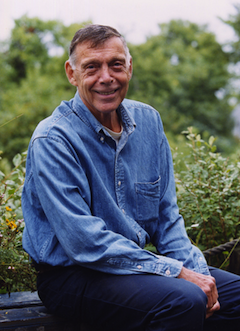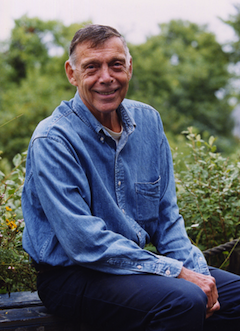
Springtime at choreographer Paul Taylor’s country place, overlooking Long Island Sound, means green shoots in the rock garden that boasts a miniature church, part of the stage set from one of his dances. Spring also means deer to nibble the shoots, and squirrels to cha-cha behind the walls of Taylor’s A-frame, and some new visitors, wild turkeys, which hang out on the deck.
When Taylor isn’t in Manhattan, rehearsing his company and living in his apartment, he’s out there, thinking up new work, writing — his second book, Facts and Fancies, was published this year — as well as gardening and coexisting with the fauna. “They don’t bother me,” he said the other day on the phone.
Taylor’s own company now bills him as “the last living member of the pantheon that created indigenous American modern dance.” The description seems a little funny and a little edgy, like a lot of the things Taylor says, and you have to wonder if he wrote it himself. But it’s true. He danced with another member of that pantheon, Martha Graham, at the beginning of his career, for seven seasons. He even danced a solo for George Balanchine (no pantheonist, he) in Episodes, an adventurous collaboration with Graham. Balanchine described Taylor as looking like a fly in a glass of milk. In reality, Taylor was a stunning mover: fast, long, and lean. Before he danced, he was a swimmer at Syracuse University. After he got the calling, he studied with Antony Tudor at the Juilliard School. His first choreography was Jack and the Beanstalk, in 1954. Three years later, he choreographed Seven New Dances, a nonmovement solo performed to the intonations of the time-check telephone lady, earning himself a review from Louis Horst that consisted only of blank space. Martha Graham called Taylor a “naughty boy.”
Since then, Taylor has received every honor the arts and government can bestow. The Paul Taylor Dance Company, founded 59 years ago, and its junior troupe, Taylor II, tour worldwide to rapturous acclaim, like the standing ovations last June at Paris’ Theatre National de Chaillot.
Taylor, 82, doesn’t go on the road with his dancers anymore. He’ll sit out their upcoming visit to the Lam Research Theater at Yerba Buena Center for the Arts, under the auspices of San Francisco Performances. He’s sending three programs for the five-day stint, including the deliciously funny Gossamer Gallants, a reminder of the choreographer’s love of insects; the haunting Last Look; and Kith and Kin and The Uncommitted, both San Francisco premieres.
Taylor’s own company now bills him as “the last living member of the pantheon that created indigenous American modern dance.”
Importantly, the company is performing The Rite of Spring (The Rehearsal) — virtuosic, tragicomic, and, like Nijinsky’s ballet a century ago, altogether unexpected. Taylor’s version premiered in 1980. “It’s hard to remember where my first idea came from,” he said on the phone, “but once I had the idea, I looked for the piano version, because I didn’t want to use the orchestral one.” Stravinsky’s two-piano reduction worked better with what he had in mind — to create a Rite in the style of “an old black-and-white movie from the 1940s or something,” he said. “I was always interested in the flat style that Nijinsky used in that piece and first used in Afternoon of a Faun. I call it ‘the Egyptian,’ where the shoulders are facing front. It makes the dancers have to twist a lot.
“I had to think about the story, and I thought about the genre of the detective novel. A girl comes to the detective, and she has a baby, and she needs something. The guy’s a jewel thief, and he has a mistress. The thing is, it switches back and forth between the [dance company’s] rehearsal for this story and the actual story, and we have these scrims for each of the stories. And the people in each of the stories relate to each other. I try not to do autobiographical dances, but the dance company setting just seemed to make sense,” Taylor said.
Kaleidoscope Abyss
“The rehearsal mistress is somehow connected to the gangster’s mistress. They sit at the mirror” — at a dressing table — “and their gestures are the same.” The sensation, for this viewer, is like falling into a kaleidoscope where all the shards are black and white — with two exceptions. The baby is swaddled in red, and the dance bag is red. And of course there is a connection between the two.
“And what the audience really likes is, the baby gets stabbed by accident, and the mother does the dance of death, which relates to both stories.” Taylor said this with a little laugh in his voice. His sense of humor seems to contrast, yet comport, with his unusual capacity for sorrow, if not tragedy, in his dances. It’s part of what has made him such a compelling choreographer. The other part belongs to his vocabulary, drawn from everyday movement as much as from any terpsichorean lexicon, and conveyed by his company with ceaseless focus and artistry.
Getting into the company is tough; Mark Morris didn’t make it, Taylor said, returning a compliment in typical backhanded style. Taylor had just heard that Morris mentioned in an SFCV interview how much he likes Taylor’s Rite of Spring (The Rehearsal). “He auditioned for me one time years and years ago, before he had his own company,” said Taylor. “I thought he was fine, but he had all this long hair. It was a bit much for that time, so I didn’t pick him. But he was really very good.”
His sense of humor seems to contrast, yet comport, with his unusual capacity for sorrow, if not tragedy, in his dances.
Another piece in the San Francisco engagement, the West Coast premiere of To Make Crops Grow, is set to part of Ferde Grofe’s Grand Canyon Suite (but not “On the Trail”). It seems as if it might have the same agrarian underpinnings as the Stravinsky Rite of Spring.
But not really. There is no chosen maiden; instead, there’s a lottery, “and you realize it’s to stone the one” who wins it, Taylor said. In fact, the scenario is from Shirley Jackson’s famed short story “The Lottery.” “We couldn’t get the permission in time to use her name,” before the premiere in New York earlier this year, Taylor said, “but now she’s credited in the program.”
To Make Crops Grow takes place in this “sort of happy farm community. It’s a nice day, everyone’s friendly, smiling. Gradually you realize they’re having a lottery … children are just picking up rocks and putting them in a pile. In my dance, the woman that gets killed is not very likable. She’s married to an older man, and she’s a terrible flirt, and when she gets stoned, she deserves it.” The dance “turned out to be a fun thing to do,” he said. “The dancers were so responsive, and seemed to understand each of their parts, and were a terrific help.”
To Make Crops Grow, he said, carries influences of his life in rural Long Island, where he takes care of the garden and repairs the house and where one day, he once told me, the mail carrier delivered his medal from the French government to the mailbox by the side of the road and put the flag up. (He’s a chevalier, now, France’s highest civilian honor. He’s also won a MacArthur “genius” award and received a Kennedy Center Honor. He can’t be knighted, but his new book does tell a story about the dilemma he faced the time Queen Elizabeth II, all unknowing, sat on his hand.)
Modern dance has always changed, from generation to generation. Right now, they’re doing things I couldn’t care less about. – Paul Taylor
Taylor is close to nature — he used to collect butterflies, until he decided it wasn’t the right thing to do — but he thinks all the talk about natural living “seems extreme to me, and sort of funny. Nowadays, people seem to be terribly conscious of their … they seem to think they’re going to die.” A chuckle. “Jogging is very bad for you. You’re on hard surfaces, which is very bad for your knees.” As for smoking, “I wouldn’t give it up for the world. I’m usually at home’’ — alone — “so nobody complains. When I have guests, I tell them it’s my place, so I can do what I want. I get them on an Indian reservation for $10 a carton, which is really very cheap.”
He does not think about mortality, he said. When his dancers return from their tour, he’ll start choreographing for next year. “I’m making two or three dances,” he said. “One of them may be short.” These days, he remarked, “I rarely go out and see other things. Modern dance has always changed, from generation to generation. Right now, they’re doing things I couldn’t care less about. There’s very little dance, if you ask me, and more talking, and gimmicks, and stuff. I’m hoping it won’t be like this forever.”
While he awaits his dancers, Taylor writes, “on a child’s word processor. It prints out and it has a limited spell check and it’s just wonderful. I love it. It’s a Canon Starwriter Jet 300. I have a couple of second-hand backups in case this one goes under. I don’t do Internet. I have this phone and this fax machine, and that’s it.”
Taylor’s first book, Private Domain, was nominated in 1987 for a National Book Critics Circle Award for biography. Facts and Fancies, a slender paperback, includes pieces that were written “years and years ago,” Taylor said. “I did them for fun, trying to learn how to write and making up challenges for myself.” Included in the “Facts” half of the book is an essay, Why I Make Dances. Taylor wrote: “To put it simply, I make dances because I can’t help it. Working on dances has become a way of life, an addiction that at times resembles a fatal disease. Even so, I’ve no intention of kicking the habit.”

